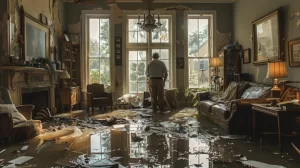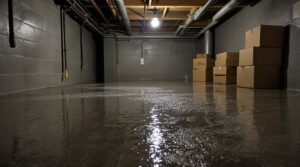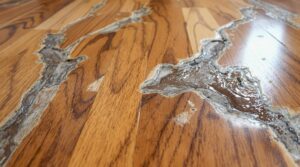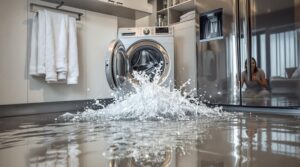Successful water damage insurance claims require immediate action and systematic documentation. Key steps include shutting off the main water valve, documenting all damage with photos and videos, and promptly notifying the insurance provider within 24-48 hours. Essential elements involve creating detailed inventories, preserving evidence, maintaining all receipts, and understanding policy coverage. Professional public adjusters can greatly increase settlement amounts, often raising payouts from $80,000 to $120,000 through expert negotiation and thorough documentation. These fundamentals establish the foundation for ideal claim outcomes.
Key Takeaways
- Document everything extensively with photos and videos, including before-and-after shots of damaged areas and items with serial numbers.
- Contact your insurance provider immediately and maintain detailed records of all communications throughout the claims process.
- Stop water flow immediately at the main valve and take protective measures like shutting off electricity before documenting damage.
- Create a comprehensive inventory of damaged items with descriptions and estimated replacement costs, keeping all relevant receipts.
- Consider hiring a public adjuster who can significantly increase settlement amounts through professional negotiation and documentation strategies.
Stop the Water Flow Immediately
When water damage occurs, swift action to stop the water flow is critical to minimize property damage and potential hazards. The first step in leak detection involves locating the main shut-off valve, typically found in water meter boxes or utility rooms.
Turn the valve clockwise, executing a 90-degree turn for ball valves or rotating until resistance for gate valves.
Emergency preparedness requires immediate safety measures, including switching off electrical power at the breaker panel to prevent shock hazards. If standing water is present, protective gloves are essential before proceeding.
After securing the main valve, drain the remaining water by opening an exterior faucet or front hose tap. For homes equipped with remote shut-off systems, utilize these centralized controls to expedite the process.
To guarantee effective response, maintain accessible emergency tool kits containing shifting wrenches, valve handles, and protective equipment.
Regular system inspections and familiarity with valve locations enhance rapid response capabilities during water emergencies.
Document Everything Before Cleanup
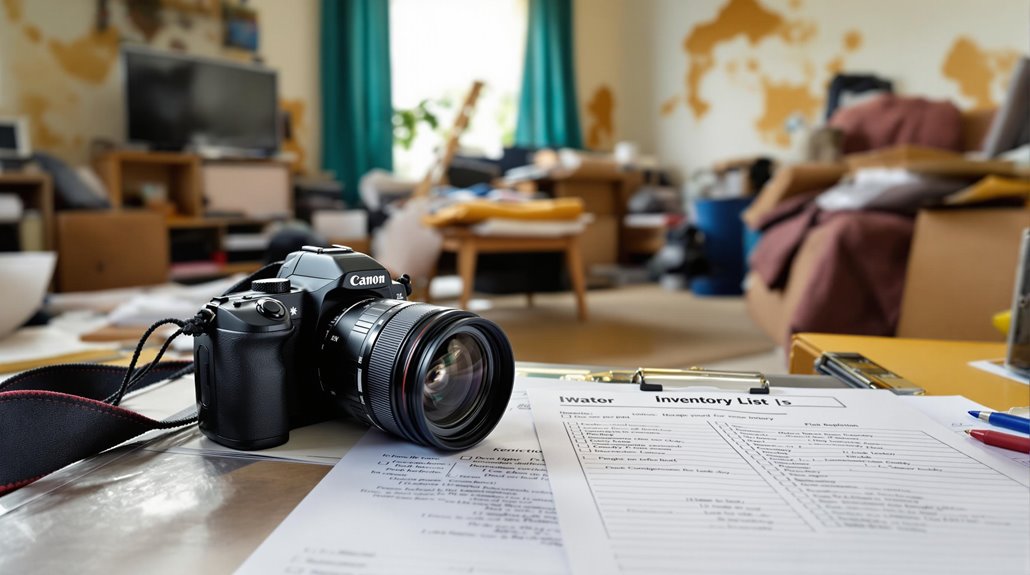
Professional documentation forms the foundation of a successful water damage insurance claim. Extensive damage documentation greatly impacts claim accuracy and guarantees proper compensation for losses. Property owners must capture both overview shots and detailed close-ups of affected areas, using well-lit conditions to clearly demonstrate the extent of damage.
A systematic approach to documentation includes creating a detailed inventory of damaged items, complete with descriptions, pre-damage conditions, and current replacement costs.
Essential documentation extends to preserving evidence by carefully storing salvageable items and photographing those that require immediate disposal. Property owners should maintain all receipts for temporary repairs and emergency services.
The final component involves completing a thorough incident report that records the date, time, and cause of water damage, along with immediate actions taken.
This report, combined with photographic evidence and inventory documentation, provides insurance adjusters with the necessary information to process claims efficiently.
Contact Your Insurance Provider Right Away
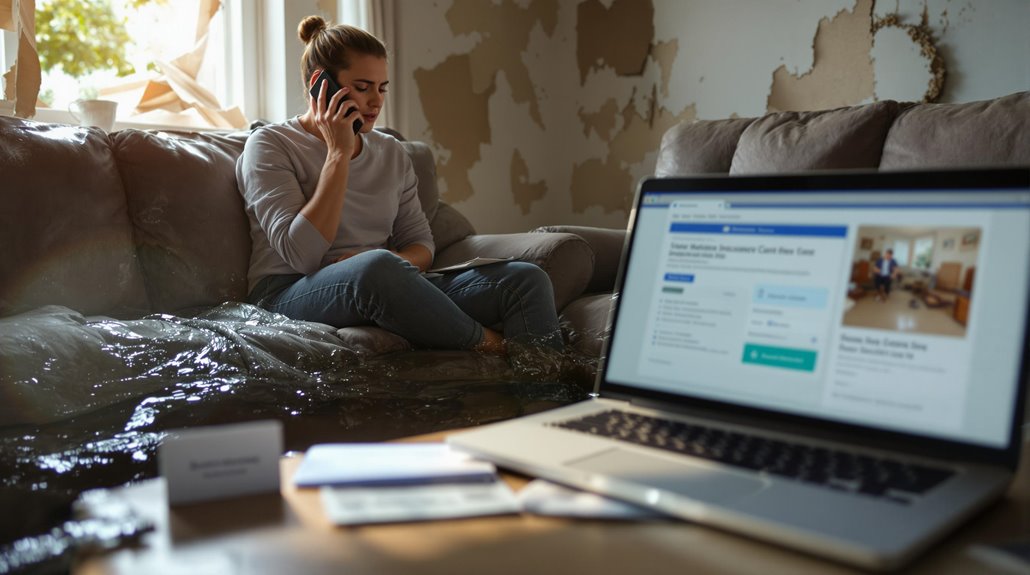
Following the discovery of water damage, property owners must immediately contact their insurance provider to initiate the claims process and guarantee compliance with policy requirements.
Insurance companies maintain 24/7 hotlines and multiple reporting channels, including online portals and mobile applications, to facilitate timely communication.
During initial contact, property owners should provide a thorough damage assessment, including the date of occurrence and preliminary documentation through photos or videos.
Insurance agents serve as valuable advocates throughout this process, often helping to identify qualified restoration professionals and ensuring satisfactory carrier response. Property owners should maintain contact with both their agent and insurance company to expedite the claims process.
Swift reporting offers multiple advantages: it accelerates settlement procedures, minimizes the risk of additional damage, and strengthens the relationship between policyholder and insurer.
Most importantly, prompt notification within 24-48 hours helps prevent secondary issues like mold growth, which could complicate the claims process and increase repair costs.
Review Your Policy Coverage Details

A thorough understanding of insurance policy coverage details forms the foundation of a successful water damage claim. Standard policies typically cover sudden and accidental water damage while excluding gradual deterioration and flood-related incidents. Policy exclusions and coverage limits vary greatly, making it vital to comprehend specific terms and conditions.
| Coverage Type | Typically Included | Usually Excluded |
|---|---|---|
| Sudden Events | Burst pipes, roof leaks | Flood damage |
| Plumbing Issues | Accidental overflows | Long-term seepage |
| Weather Impact | Rain through storm damage | Groundwater infiltration |
Homeowners should note that while standard policies cover water damage from malfunctioning appliances and sudden plumbing failures, they generally exclude damage from maintenance neglect. Optional endorsements can extend protection for specific scenarios like sewer backups and sump pump failures. Regular policy reviews guarantee awareness of coverage gaps and help determine if additional riders are necessary for extensive protection against water-related perils.
Take Photos and Videos of All Damage
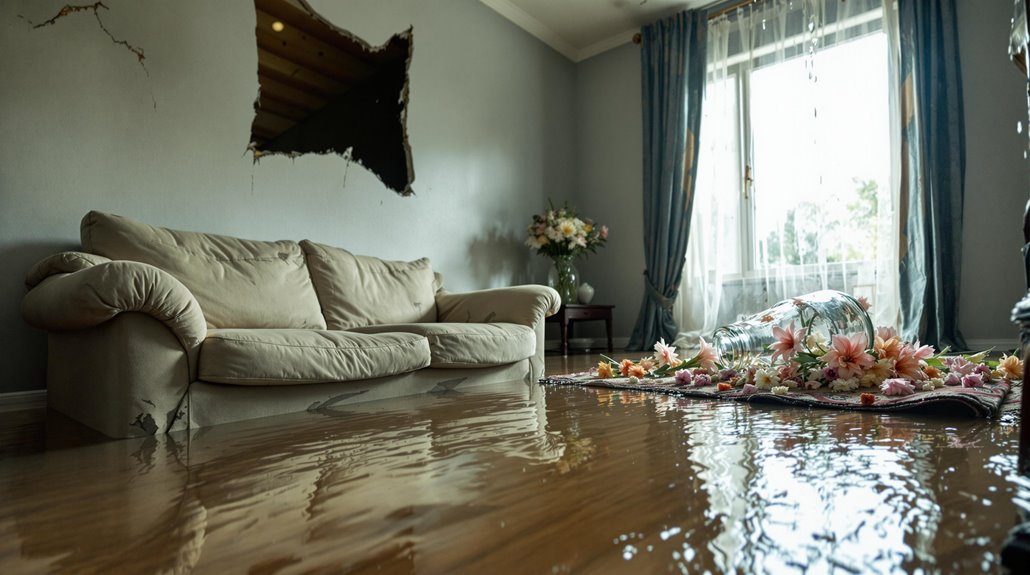
Thorough photographic documentation forms an essential foundation for water damage insurance claims, requiring systematic capture of all affected areas from multiple angles.
High-resolution photos and videos should document every instance of damage, including close-ups of affected items, structural impacts, and any standing water present.
Maintaining a collection of "before" photos of the property can considerably strengthen the claim by establishing clear evidence of pre-damage conditions and supporting the full scope of losses incurred.
Document Every Affected Area
When filing a water damage insurance claim, homeowners must thoroughly document every affected area through systematic photography and videography of the damage. The documentation should include detailed overview shots of affected surfaces and detailed close-ups that clearly show damage categories in each room or space.
For each affected area, homeowners should create a methodical inventory listing all damaged items, including their pre-damage condition, model numbers, and serial numbers where applicable.
This documentation must capture multiple angles under proper lighting conditions to guarantee visibility of water damage patterns and extent. The inventory should detail specific locations of damage, such as walls, floors, ceilings, and personal property, accompanied by estimated replacement costs and current market values.
This systematic approach guarantees a complete record for insurance adjusters to evaluate the claim accurately.
Capture Before And After
Taking systematic before and after photographs and videos serves as the foundation for a thorough water damage insurance claim. Property owners should capture wide-angle shots of affected areas while documenting specific damages from multiple angles with proper lighting and time stamps.
Effective documentation requires attention to detail, including close-up shots of valuable items, serial numbers, and hidden areas where damage may be less obvious. Using rulers or reference objects to show water levels provides essential context for adjusters.
For extensive photo organization, homeowners should maintain digital backups and create detailed photo logs with descriptions. Documentation should extend to the damage source, such as broken pipes or roof leaks, and include measurements of affected areas.
This systematic approach guarantees all evidence is preserved for the claims process.
Keep Records of Emergency Repairs

Maintaining extensive documentation of emergency water damage repairs requires meticulous record-keeping of all receipts, invoices, and expenses incurred during the restoration process.
Property owners should capture detailed photographs and video footage both before repairs commence and throughout each stage of the repair work to establish a clear timeline of restoration efforts.
These records, combined with dated documentation of specific repair activities, create a thorough paper trail that supports insurance claims and validates the necessity of emergency interventions.
Save All Repair Receipts
Preserving repair receipts represents a crucial step in the water damage insurance claims process. Proper receipt organization guarantees thorough documentation of all emergency repairs, materials, and professional services required during water damage mitigation.
Insurance providers rely on these records to process claims efficiently and accurately.
Effective documentation tips include maintaining chronological records of all expenses, creating detailed descriptions for each repair, and storing receipts in a secure, accessible location.
Property owners should capture photographic evidence alongside receipts, establishing a clear connection between damages and repairs performed. An itemized list of expenses, complete with dates and specific costs, strengthens the claim's validity and expedites reimbursement.
This systematic approach to receipt management demonstrates policy compliance and proactive damage control measures to insurance adjusters.
Document Before and After
Thorough documentation of water damage conditions before and after repairs serves as a cornerstone of successful insurance claims. The damage assessment process requires extensive visual documentation, including photographs, videos, and detailed written records of the affected areas.
| Documentation Element | Required Actions |
|---|---|
| Initial Assessment | Record date, time, weather conditions, and pre-existing warning signs |
| Emergency Response | Log immediate repairs, mitigation efforts, and professional services |
| Final Documentation | Capture post-repair conditions, remaining issues, and total costs |
Property owners should maintain chronological records of all communications with insurance representatives, including names and discussion details. This documentation should encompass initial damage state, emergency repairs performed, and final restoration outcomes, creating a clear timeline of events and actions taken throughout the claim process.
Take Photos While Working
Visual documentation during emergency water damage repairs plays an essential role in substantiating insurance claims. The repair process requires systematic photo documentation from multiple angles, including wide-angle shots to demonstrate the full scope of damage and close-up images detailing specific repairs and materials used.
Proper documentation includes time-stamped photographs taken under adequate lighting conditions, capturing both before and after conditions of affected areas. Digital images should show specialized equipment deployment, structural modifications, and safety measures implemented during repairs.
Maintaining chronological records of all repairs, including professional services rendered and materials used, strengthens the claim's validity. Creating secure digital backups of all visual evidence, along with corresponding receipts and detailed descriptions, guarantees a thorough record for insurance adjusters to evaluate the claim accurately.
Create a Detailed Inventory List

A complete inventory list serves as the cornerstone of a successful water damage insurance claim. Proper inventory organization requires documenting each damaged item with specific details including item descriptions, pre-damage conditions, estimated values, replacement costs, and purchase dates.
For ideal item valuation, claimants should include original receipts and serial numbers when available. The inventory should be categorized systematically, separating items into groups such as furniture, electronics, and personal belongings.
Extensive photographic documentation of each damaged item provides visual evidence to support the claim. This detailed approach helps prevent disputes about item conditions and values while expediting the claims process.
To maintain accuracy, the inventory list should be regularly updated to reflect new purchases and stored securely with multiple copies. Professional assistance may be warranted for complex inventories.
A meticulously maintained inventory list not only facilitates current claims but also serves as valuable documentation for future insurance needs.
Work With a Professional Adjuster

Working with a professional adjuster markedly streamlines the water damage claims process by leveraging their expertise in policy interpretation and damage assessment.
Professional adjusters maintain meticulous documentation standards and employ systematic approaches to inventory creation, ensuring all damages are properly cataloged and substantiated.
Their specialized knowledge of insurance protocols and negotiation experience can expedite claim resolution while maximizing the potential for a fair settlement.
Accelerate Your Claim Process
To expedite the water damage insurance claim process, engaging a professional adjuster proves instrumental in maneuvering complex procedures and securing ideal settlements. Professional adjusters streamline claim timelines through expert documentation, detailed damage assessments, and efficient communication tips with insurance providers.
| Action Item | Benefit |
|---|---|
| Documentation Management | Maintains organized records of damage and repairs |
| Professional Assessment | Utilizes advanced tools for accurate evaluation |
| Strategic Communication | Handles all interactions with insurance companies |
| Settlement Negotiation | Maximizes claim value through expert knowledge |
These specialists employ thermal imaging and moisture meters to identify hidden damages, ensuring thorough coverage. Their expertise in insurance laws and policies enables them to counter inadequate offers and advocate effectively for policyholders' interests. By managing all aspects of the claim process, professional adjusters greatly reduce settlement delays while securing optimal compensation for water damage repairs.
Document Everything With Precision
Professional documentation serves as the backbone of successful water damage insurance claims, requiring meticulous attention to detail and systematic recording methods. Working with a public adjuster streamlines this process through extensive assessment and thorough documentation of both visible and concealed damage.
Effective documentation includes capturing digital evidence through photos and videos from multiple angles, maintaining detailed inventories of affected items with their corresponding item values, and preserving all related receipts and correspondence.
Color-coded spreadsheets help organize damaged belongings by category, while time-stamped photos authenticate the timeline of events. Public adjusters leverage their expertise to identify additional damage points, manage documentation requirements, and negotiate with insurance providers.
This systematic approach to documentation maximizes claim potential and expedites the settlement process through professional oversight.
Save All Receipts and Estimates

Since insurance companies require detailed documentation of expenses, maintaining an extensive record of all receipts and estimates is essential for successful water damage claims. Implementing a systematic receipt organization system guarantees all expenses are properly tracked and readily accessible during the claims process.
Property owners should collect and preserve documentation for all costs, including temporary accommodations, repair services, materials, and cleaning expenses. Utilizing a spreadsheet for expense tracking helps categorize different types of expenditures while maintaining chronological order. Digital backups provide additional security for these critical documents.
When submitting documentation to insurers, property owners must ascertain all receipts and estimates are legible and accompanied by detailed descriptions. Each expense requires verification for authenticity and necessity under the policy terms.
Prompt submission of all documentation, followed by confirmation of receipt from the insurance company, helps expedite the claims process and minimize potential delays.
Follow Up on Your Claim Regularly

Following the meticulous documentation of expenses and receipts, property owners must maintain consistent communication with their insurance company throughout the claims process.
Effective claim follow up involves regularly checking the status, maintaining detailed records of all interactions, and scheduling prompt meetings with adjusters to expedite evaluations.
Property owners should implement strategic communication strategies, including written correspondence to document all discussions and agreements.
Utilizing online tracking platforms provided by insurers enables real-time monitoring of claim progress.
When engaging with insurance representatives, maintaining a professional tone while being proactively engaged helps address potential delays or concerns efficiently.
If the claim process stalls, understanding escalation procedures becomes essential.
Property owners should regularly solicit feedback from adjusters, review submitted documentation for accuracy, and advocate for timely resolution.
In complex cases, seeking professional assistance may be necessary to navigate negotiations and guarantee appropriate settlement based on policy coverage.
The Benefits Of Consulting A Public Adjuster

Consulting a public adjuster provides expertise in complex insurance claims and guarantees an objective assessment of water damage through advanced diagnostic tools and methodologies.
Public adjusters streamline the claims process by handling documentation, negotiations, and communications with insurance companies while advocating for the policyholder's interests.
Studies demonstrate that property owners who engage public adjusters typically receive higher claim settlements compared to those who navigate the process independently, due to their thorough documentation and professional negotiation strategies.
Expertise In Insurance Claims
When dealing with water damage insurance claims, obtaining the services of a public adjuster can provide invaluable expertise and professional guidance throughout the claims process.
These insurance claim strategies include thorough policy interpretation, detailed documentation management, and skilled negotiations with insurance companies.
Public adjuster benefits extend beyond basic claim handling, as these professionals possess extensive knowledge of insurance regulations and industry practices.
They accurately interpret policy terms, identify overlooked coverages, and guarantee compliance with all procedural requirements.
Their specialized expertise enables them to prepare detailed documentation, maintain detailed inventories of damages, and substantiate every aspect of the claim.
Moreover, their tactical awareness of insurance company practices allows them to effectively counter minimization attempts and secure favorable settlements while reducing the policyholder's stress and time investment.
Objective Damage Assessment
A public adjuster's objective damage assessment serves as the foundation of a successful water damage insurance claim.
These professionals employ sophisticated damage evaluation techniques, including moisture meters and thermal imaging technology, to document both visible and concealed water-related issues. This extensive approach guarantees the identification of hidden water issues that might otherwise go undetected, such as structural compromise or mold proliferation.
The systematic assessment process involves a thorough examination of the property, with particular attention to areas where water damage may not be immediately apparent.
This meticulous documentation and evaluation are vital for establishing the full scope of restoration needed to return the property to its pre-loss condition, ultimately supporting the maximum possible settlement for the policyholder.
Streamlined Claim Process
By engaging a public adjuster for water damage claims, policyholders gain access to a streamlined process that greatly reduces administrative burdens while maximizing potential settlements.
These licensed professionals possess extensive policy understanding and expertise in claim negotiation, ensuring ideal representation throughout the process.
Key aspects of their service include:
- Management of all communications with insurance companies, including documentation submission and progress tracking
- Professional interpretation of complex policy terms and requirements, preventing potential disputes
- Dedicated oversight of the entire claims process, from initial filing through final settlement
Public adjusters serve as advocates exclusively for the policyholder, allowing property owners to focus on recovery while ensuring their interests are protected.
Their expertise in maneuvering complex claims procedures often results in more favorable settlement outcomes.
Higher Claim Payouts & Settlements
Studies consistently demonstrate that engaging public adjusters for water damage claims leads to substantially higher settlement amounts compared to self-managed claims.
Through advanced claim negotiation techniques and extensive understanding of insurance policy nuances, public adjusters leverage their expertise to maximize compensation.
Case studies reveal significant increases in settlement amounts, with documented examples of claims rising from $80,000 to $120,000 through professional intervention.
Public adjusters achieve these results by employing specialized assessment tools, including moisture meters and thermal imaging, to identify concealed damage.
Their thorough documentation and skilled negotiations counter insurance companies' tendency to undervalue claims.
Operating on a contingency fee basis, they provide expert representation without requiring upfront costs, making their services accessible while ensuring policyholders receive fair compensation for both visible and hidden water damage.
About The Public Claims Adjusters Network (PCAN)

Professional advocacy stands at the core of the Public Claims Adjusters Network (PCAN), an extensive network of licensed insurance claim specialists who work independently on behalf of policyholders.
PCAN benefits include expert navigation of complex claims processes, maximized settlement outcomes, and significant stress reduction for clients dealing with water damage incidents.
Adjuster qualifications within PCAN emphasize technical expertise and specialized training, ensuring thorough support throughout the claims process. Operating across all 50 states and internationally, these professionals maintain strict ethical standards while delivering personalized claim strategies.
Key aspects of PCAN's approach include:
- Early involvement to prevent documentation errors and expedite settlements
- Advanced technological solutions for accurate damage assessment
- Strategic negotiation with insurance carriers to secure equitable outcomes
The network's fee structure varies by state and claim size, with standard rates typically capped at 20% for regular claims and adjusted rates for emergency situations or large-scale losses.
Frequently Asked Questions
Will Filing a Water Damage Claim Increase My Insurance Premiums?
Filing water damage claims typically results in insurance premium increases of 7-10%, though increases can reach 30-60% depending on location, claim frequency, and insurer-specific risk assessment policies.
How Long Does Mold Typically Take to Develop After Water Damage?
In a documented basement flood case, visible mold colonies emerged within 72 hours. Typically, mold growth initiates within 24-48 hours post-water damage, with colonies becoming apparent between 3-12 days without prevention measures.
Can I Stay in My Home During Water Damage Restoration?
Residence occupancy during restoration depends on safety concerns, including contamination levels and structural integrity. The restoration timeline and equipment requirements also influence whether temporary relocation is necessary for occupant wellbeing.
What if My Neighbor's Water Damage Affects My Property?
Catastrophic water intrusion from neighboring properties demands immediate documentation and investigation. Property owners should promptly assess neighbor liability, file insurance claims, and seek legal counsel if necessary for damage compensation.
Should I Notify My Mortgage Company About Water Damage Claims?
Mortgage notification is mandatory when filing water damage claims. Property owners must inform their mortgage company, facilitating proper insurance communication and ensuring coordinated claim processing through established lender-specific protocols.

